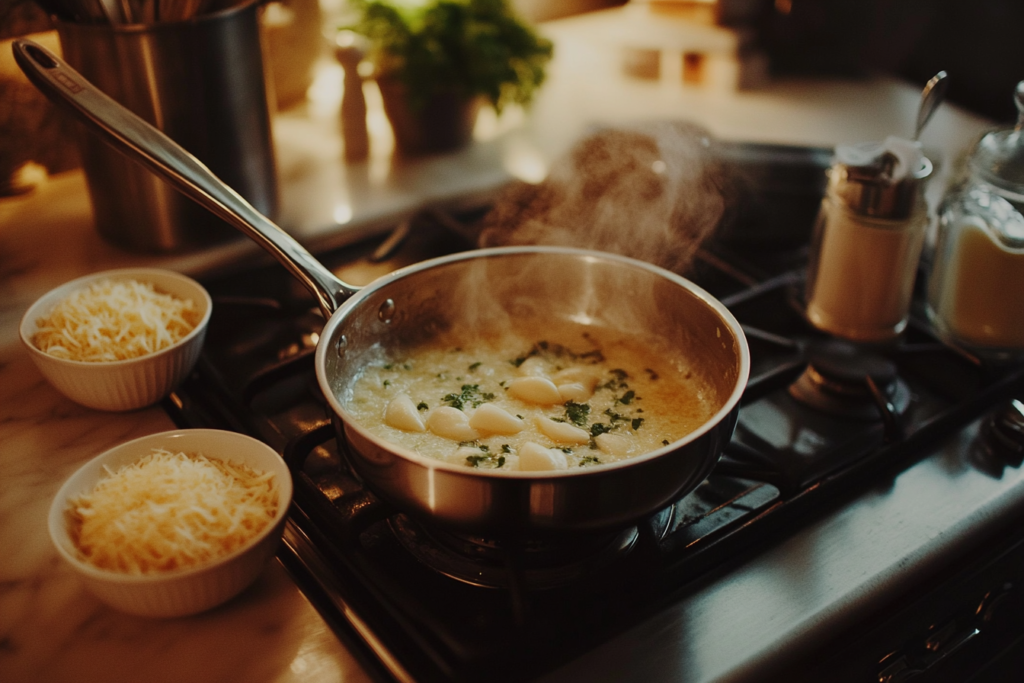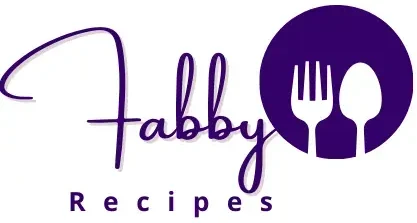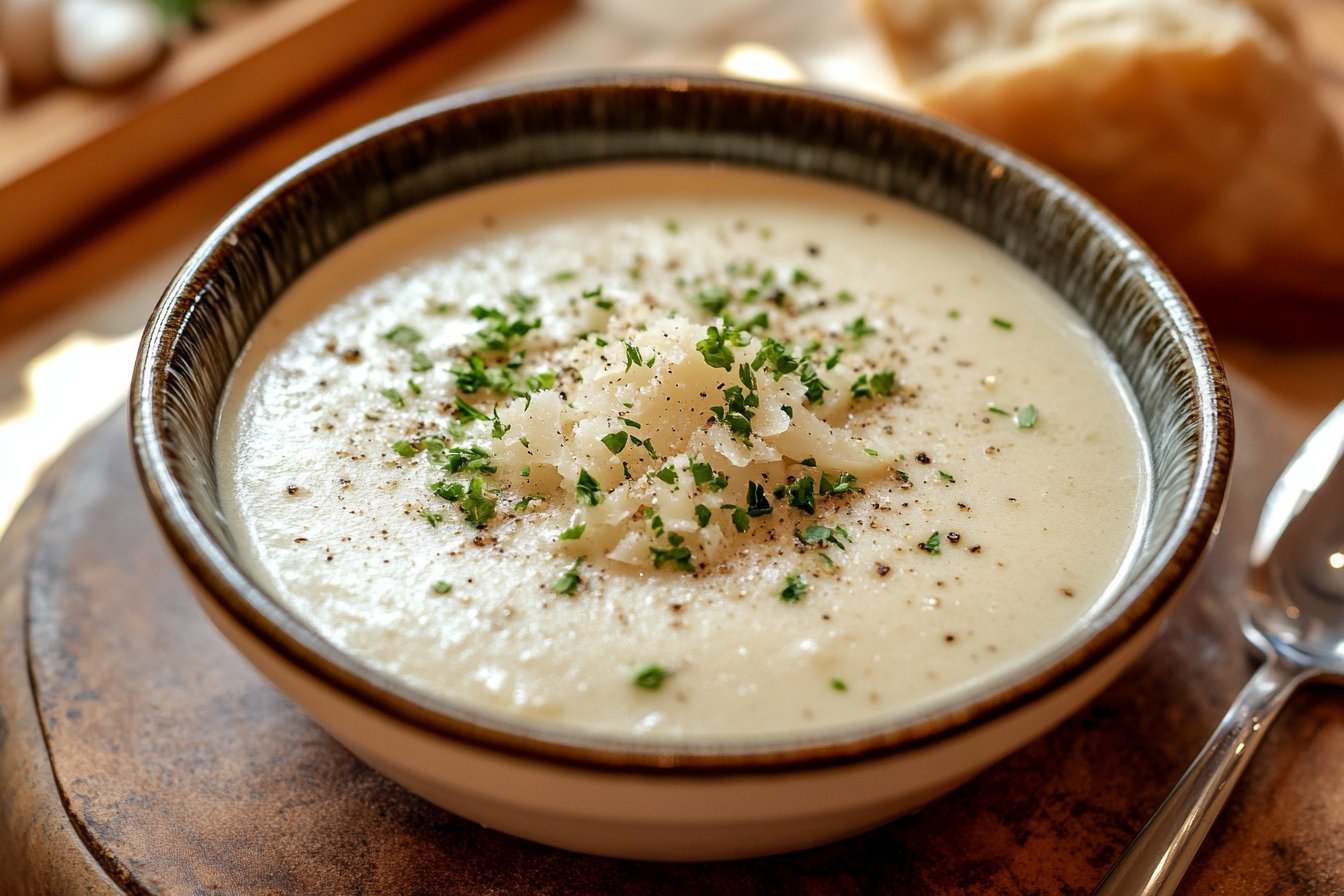Garlic Parmesan sauce has become a culinary darling for its creamy texture and savory flavor. From topping pasta to smothering chicken wings, it brings an irresistible richness that elevates any dish it graces. But what exactly goes into this velvety masterpiece?
This article dives deep into the core ingredients, preparation techniques, variations, and storage tips for garlic Parmesan sauce. Whether you’re a cooking enthusiast or a beginner, this guide will provide insights that make it simple to craft your own version at home. Let’s explore what makes this sauce a favorite across kitchens worldwide.
Introduction
What Is Garlic Parmesan Sauce Made Of?
Garlic Parmesan sauce is a creamy, versatile condiment adored for its perfect balance of savory Parmesan, fragrant garlic, and a rich dairy base. It’s a staple in Italian-inspired cuisine, often used to add a luscious texture and bold flavor to dishes. But this sauce isn’t just a one-trick pony! You’ll find it in a variety of recipes, from pizza to veggies.
At its heart, the sauce includes simple yet impactful ingredients: fresh garlic, grated Parmesan cheese, heavy cream, and butter. Additional seasonings, like black pepper and parsley, give it a delightful complexity. Whether made for a hearty pasta dish or a zesty dip for breadsticks, garlic Parmesan sauce has earned its reputation as a crowd-pleaser.
Through this article, you’ll uncover the secrets of its preparation, explore creative variations, and learn practical tips for making your own restaurant-quality sauce at home.
Core Ingredients
Garlic: The Flavor Foundation
When it comes to garlic Parmesan sauce, garlic is undeniably the hero ingredient. Its pungent aroma and bold taste create a flavor profile that is both sharp and savory, anchoring the sauce in a world of deliciousness.
The way garlic is prepared makes a big difference. Minced garlic, for instance, releases intense, punchy flavors that pack a strong kick, perfect for those who crave a bold taste. On the other hand, roasted garlic brings a mellow, sweet note, adding depth without overpowering the dish.
To unlock its full potential, garlic is typically sautéed in butter or oil before being incorporated into the sauce. This step not only softens its sharpness but also infuses the base with a rich, aromatic foundation. Whether finely chopped or roasted whole and mashed, garlic is the cornerstone of this beloved sauce, providing its unmistakable savory essence.
Parmesan Cheese: The Umami Element
Parmesan cheese, the second star of the show, adds a creamy, nutty, and salty richness that makes garlic Parmesan sauce truly luxurious. Its umami punch is what elevates the sauce from good to unforgettable.
Freshly grated Parmesan is essential for achieving the best flavor and texture. Pre-shredded or powdered versions often contain additives that can prevent them from melting smoothly, leading to a less cohesive sauce. Grating the cheese right before use ensures a velvety texture and the brightest, most authentic taste.
Beyond flavor, Parmesan plays a structural role. As it melts into the sauce, it thickens and adds body, creating a luscious consistency. By using high-quality Parmesan cheese, you guarantee a sauce that’s both indulgent and balanced.
Dairy Base: Cream, Milk, or Butter
No garlic Parmesan sauce would be complete without its creamy foundation. Dairy products like heavy cream, milk, and butter are key to achieving the sauce’s signature silkiness.
Heavy cream is the most common choice, offering richness and a luxurious mouthfeel. Milk, though lighter, can work well for those seeking a less calorie-dense option. Butter, often melted and combined with garlic, provides a velvety start and enhances the overall flavor.
These ingredients don’t just add texture—they also act as a canvas for the Parmesan and garlic to shine. When heated gently and stirred together, they form a harmonious blend that’s both comforting and decadent.
Thickening Agents: Flour and Alternatives
To give the sauce its body, a thickening agent is often required. Traditionally, a roux made from flour and butter is used. This classic technique involves cooking the two together to create a paste, which, when combined with dairy, prevents the sauce from feeling watery.
For those avoiding gluten, cornstarch or arrowroot powder are excellent alternatives. They can be mixed with a little cold water to form a slurry before being added to the sauce. These substitutes deliver the same thickening power without altering the flavor or compromising dietary restrictions.
By carefully selecting and using the right thickening agent, you ensure a sauce that clings beautifully to pasta, chicken, or vegetables.
Seasonings: Salt, Pepper, and Herbs
Finally, the seasonings tie it all together. Simple yet essential, salt and black pepper highlight the natural flavors of the garlic and Parmesan, ensuring the sauce is anything but bland.
Freshly cracked black pepper adds a subtle heat, while salt balances and enhances the richness of the dairy base. Beyond these basics, herbs like parsley, thyme, or Italian seasoning introduce freshness and complexity.
For a pop of color and an aromatic boost, chopped parsley is often sprinkled on top of the finished sauce. With the perfect blend of seasonings, garlic Parmesan sauce becomes an irresistible medley of bold and balanced flavors.
Preparation Techniques
Sautéing Garlic for Optimal Flavor
Sautéing garlic is the first and perhaps most crucial step in making garlic Parmesan sauce. This simple process transforms raw garlic into a fragrant, mellow base that infuses the entire sauce with depth and richness.
To start, melt butter or heat a splash of olive oil in a skillet over medium heat. Add finely minced garlic to the pan, stirring constantly to prevent burning. Within seconds, the kitchen will fill with an irresistible aroma—a clear sign the garlic is releasing its natural oils and flavor.

The key here is timing. Garlic can quickly shift from golden and fragrant to bitter and burnt, so watch it carefully. As soon as the edges turn light brown, it’s time to move on to the next step or incorporate the garlic into the roux. By mastering the art of sautéing, you set the stage for a sauce that’s aromatic and balanced.
Creating a Roux for Thickening
A roux, the classic combination of butter and flour, is the backbone of a perfectly thickened garlic Parmesan sauce. It ensures the sauce isn’t watery and provides a silky mouthfeel.
Begin by melting butter in a saucepan over medium heat. Once it’s fully melted, whisk in an equal amount of flour. Stir continuously, allowing the mixture to cook for about two minutes. This step eliminates the raw flour taste and creates a pale golden paste.
The consistency of the roux is crucial—it should be smooth, not lumpy. If the butter and flour separate or clump, reduce the heat and keep whisking. A well-made roux acts as a sturdy base, ensuring the sauce coats every strand of pasta or piece of chicken beautifully.
Incorporating Dairy for Creaminess
Once the roux is ready, it’s time to add the dairy. This step requires patience and technique to achieve the velvety texture that garlic Parmesan sauce is known for.
Gradually pour in warm milk, cream, or a combination of both while whisking continuously. Adding dairy too quickly can result in lumps, so it’s best to go slow and steady. The warm liquid helps the roux dissolve evenly, creating a smooth blend without graininess.
As the mixture simmers, it will thicken into a luxurious, creamy base. Stir frequently to prevent sticking or scorching, and adjust the heat as necessary. This creamy canvas is now ready to embrace the bold flavors of garlic and Parmesan.
Melting Parmesan for Texture
Parmesan cheese isn’t just an ingredient; it’s the soul of garlic Parmesan sauce. Melting it properly is key to achieving a luscious texture that feels indulgent in every bite.
Start by lowering the heat to prevent the dairy from scorching. Gradually sprinkle freshly grated Parmesan into the sauce while stirring constantly. Adding the cheese in small batches allows it to melt evenly, creating a cohesive, silky mixture.
Avoid overheating the sauce, as this can cause the cheese to become stringy or clump together. Stir until the Parmesan fully integrates, enriching the sauce with its nutty, umami goodness. With every stir, you’re bringing the sauce closer to its creamy perfection.
Adjusting Seasonings to Taste
The final step in crafting the perfect garlic Parmesan sauce is fine-tuning the flavor. Seasoning may seem simple, but it’s what transforms a good sauce into a great one.
Start with a pinch of salt and a generous grind of black pepper. Taste the sauce frequently as you season to avoid overpowering the delicate balance of flavors. If the sauce feels too rich, a dash of lemon juice or a sprinkle of fresh herbs like parsley can brighten it up.
For an extra kick, consider a pinch of red pepper flakes or a dusting of nutmeg. These subtle additions enhance the complexity without stealing the spotlight. Remember, the best seasoning is the one that suits your palate, so don’t be afraid to experiment. With the perfect seasoning, your sauce will be a masterpiece!
Variations and Uses
Gluten-Free Garlic Parmesan Sauce
For those following a gluten-free diet, modifying the traditional garlic Parmesan sauce is easier than you might think. The key adjustment lies in replacing all-purpose flour, often used as a thickening agent, with gluten-free alternatives like cornstarch or arrowroot powder.
To start, skip the roux-making process. Instead, dissolve a tablespoon of cornstarch in two tablespoons of cold water to create a slurry. Once your butter, garlic, and dairy are combined and heated, slowly whisk in the slurry. This will thicken the sauce without altering its creamy texture or flavor.
Beyond thickening, ensure that other ingredients like Parmesan cheese and seasonings are certified gluten-free. Many grated cheeses and spice blends can sometimes contain hidden gluten, so checking labels is essential. With these simple tweaks, you can enjoy a gluten-free version of this classic sauce that tastes just as rich and indulgent.
Vegan Alternatives
Crafting a vegan-friendly garlic Parmesan sauce is not only possible but also incredibly delicious. The secret lies in plant-based substitutions for dairy and cheese, allowing you to replicate the creamy, savory goodness without compromising your values or dietary needs.
For the dairy base, coconut cream, almond milk, or cashew cream work beautifully. Cashew cream, in particular, offers a texture and richness remarkably close to traditional cream. Replace butter with a vegan alternative or olive oil for a smooth start.
As for Parmesan, nutritional yeast is the go-to substitute. Its nutty, cheesy flavor mimics the essence of Parmesan without the dairy. Some recipes also incorporate vegan Parmesan cheese, made from nuts and seeds, for an authentic touch.
Sauté your garlic as usual, then combine the plant-based ingredients and season to taste. The result? A vegan garlic Parmesan sauce so creamy and flavorful, you’ll forget it’s dairy-free.
Culinary Applications
The versatility of garlic Parmesan sauce is one of its most appealing qualities. Its creamy texture and bold flavors make it a match for a wide array of dishes, ensuring it earns its place in your recipe repertoire.
Pasta is the most obvious pairing. Toss your favorite noodles in the sauce for a comforting, restaurant-quality dish. For meat lovers, drizzle it over chicken wings or baked chicken breasts for a rich, tangy twist.
This sauce also doubles as a pizza base, creating a creamy alternative to traditional tomato sauce. Spread it thinly, top with mozzarella, and bake for a white pizza that’s both decadent and satisfying. If you’re curious about how garlic Parmesan sauce compares to other classics like Alfredo, check out our guide: Is Garlic Parmesan Sauce the Same as Alfredo? Key Differences Explained.
Vegetables shine under this sauce’s creamy embrace, too. Pour it over steamed broccoli or roasted cauliflower for a side dish that’s anything but ordinary. And don’t forget dipping—breadsticks, garlic knots, or even fries are elevated by the sauce’s irresistible flavor.
Whatever the dish, garlic Parmesan sauce adds a touch of indulgence and sophistication, transforming everyday meals into something extraordinary.
Storage and Safety
Storage Guidelines
Storing leftover garlic Parmesan sauce properly is essential for maintaining its quality and flavor. Begin by allowing the sauce to cool to room temperature before transferring it to an airtight container. This prevents condensation, which can affect the texture and taste.
Once sealed, place the container in the refrigerator. The sauce will stay fresh for up to five to seven days. For longer storage, consider freezing it. Pour the cooled sauce into a freezer-safe container or a resealable plastic bag, leaving a bit of room for expansion. Frozen, it can last up to three months.
When reheating, low and slow is the way to go. Heat the sauce gently on the stovetop over low heat, stirring constantly to prevent separation. If the texture seems grainy or too thick, add a splash of milk or cream and whisk until smooth. These steps will ensure your sauce retains its creamy consistency and delicious flavor.
Food Safety Considerations
Ensuring the safety of your garlic Parmesan sauce starts with proper handling during preparation. Always use fresh ingredients and clean utensils to minimize contamination risks. When cooking, bring the sauce to a simmer to kill any bacteria present in the dairy or garlic.
Once cooked, avoid leaving the sauce at room temperature for longer than two hours. Bacteria can multiply rapidly between 40°F and 140°F, so refrigeration is crucial. Transfer leftovers to the fridge promptly and ensure they’re stored in a sealed container to prevent cross-contamination.
When reheating, make sure the sauce reaches an internal temperature of at least 165°F. This step is especially important if the sauce contains cream or milk, as dairy products can harbor bacteria if not properly heated. By following these guidelines, you can enjoy your homemade sauce without worry.
Frequently Asked Questions
Can I make garlic Parmesan sauce without dairy?
Yes, you can make a dairy-free version of garlic Parmesan sauce by swapping traditional ingredients with plant-based alternatives. Almond milk or cashew cream provides a creamy base, while nutritional yeast offers the cheesy flavor of Parmesan. Vegan butter or olive oil can replace traditional butter, creating a sauce that’s just as flavorful and satisfying.
How can I thicken the sauce without flour?
If you’re avoiding flour, cornstarch and arrowroot powder are excellent gluten-free alternatives for thickening garlic Parmesan sauce. Mix one tablespoon of cornstarch with two tablespoons of cold water to create a slurry, then whisk it into the sauce while it simmers. This method thickens the sauce without compromising its creamy consistency.
What dishes pair best with garlic Parmesan sauce?
Garlic Parmesan sauce is a culinary chameleon, complementing countless dishes. Toss it with pasta for a decadent main course, drizzle it over crispy chicken wings for game day, or use it as a rich base for white pizza. It also enhances roasted vegetables like broccoli and cauliflower, making them irresistible side dishes.
How long does homemade garlic Parmesan sauce last?
Stored in an airtight container in the refrigerator, homemade garlic Parmesan sauce stays fresh for five to seven days. Ensure the sauce is cooled completely before storing to avoid condensation, which can dilute its creamy texture. Properly stored, your sauce will be ready for reheating whenever needed.
Can I freeze garlic Parmesan sauce?
Freezing garlic Parmesan sauce is an option, but it’s worth noting that its texture may change slightly when thawed. To freeze, pour the cooled sauce into a freezer-safe container or bag, leaving space for expansion. Thaw in the refrigerator overnight, then reheat gently, whisking to restore its smooth consistency.
Is garlic Parmesan sauce gluten-free?
Traditional garlic Parmesan sauce includes flour as a thickening agent, which contains gluten. However, you can make it gluten-free by replacing the flour with cornstarch or arrowroot powder. These alternatives thicken the sauce effectively while keeping it safe for those with gluten sensitivities.


1 thought on “What Is Garlic Parmesan Sauce Made Of? A Complete Guide”